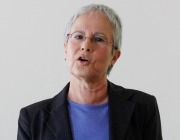We study spectral properties of quasi-one-dimensional extended systems that show deterministic diffusion on the classical level and Anderson localization in the quantal description. Using semi-classical arguments we relate universal aspects of the spectral fluctuations to features of the set of classical periodic orbits, expressed in terms of the probability to perform periodic motion, which are likewise universal. This allows us to derive an analytical expression for the spectral form factor which reflects the diffusive nature of the corresponding classical dynamics. It defines a novel spectral universality class which covers the transition between GOE statistics in the limit of a small ratio of the system size to the localization length, corresponding to the ballistic regime of disordered systems, to Poissonian level fluctuations in the opposite limit. Our semi-classical predictions are illustrated and confirmed by a numerical investigation of aperiodic chains of chaotic billiards.
We study the long-time behavior of the quantized baker's map in the semiclassical approximation. Our main object of investigation is the trace of the (n-step) time-evolution operator. We express this trace as a phase-space integral which equals the semiclassical expression in terms of periodic orbits. This enables us to follow the evolution explicitly up to the time at which the semiclassical traces start to diverge exponentially from the quantum ones. Our data indicate that this breakdown time scales with h in a way close to h-1/2.
